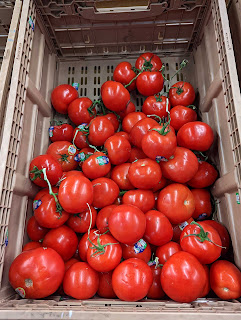 |
| Wilf P, MR Carvalho, MA Gandolfo, NR Cúneo. 2017. Eocene lantern fruits from Gondwanan Patagonia and the early origins of Solanaceae. Science, v. 355, p. 71-75, 6 January 2017. DOI: 10.1126/science.aag2737. Image from figshare.com CC by 4.0 |
Today's posting shows a fossil from the Solanaceae or nightshade family. It is called Physalis infinemundi (Wilf, 2017). When alive, it grew in Patagonia (location now known as Chubut Province, Argentia; about 52 million years ago Paleocene Epoch, Paleogene Period). Fossil was named by Peter Wilf of Penn State University in 2017. This fossil is curated at Museo Paleontológico Egidio Feruglio in Trelew, Chubut, Argentina. It appears to be Physalis fruit also known as a fossil tomatillo. Moving ahead in time to the present, shown below is a picture of a tomato today grown with some of the latest agricultural technology.
Recently, I was interested in tomatoes after buying some in the produce section of the local Walmart. The tomatoes were quite good being that Kentucky is in the winter time. As it turns out the tomatoes were grown in Kentucky at an in door farm located in the Appalachia region of the state by AppHarvest. Doing some research into this company I was impressed that they were: bringing jobs to Appalachia, using recycled rainwater, growing enclosed thus no harsh chemical pesticides/LED lighting, climate controlled buildings where bees used for pollination, and robotic harvesting.
I used the tomatoes on garden salads and as one of the vegetables on burritos. They were very tasty! Picture below of tomatoes at the Walmart produce section.
Sources:



